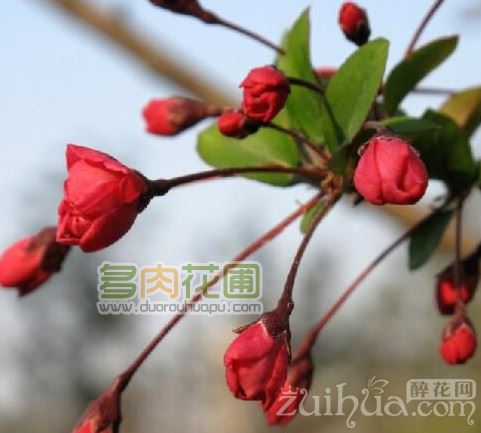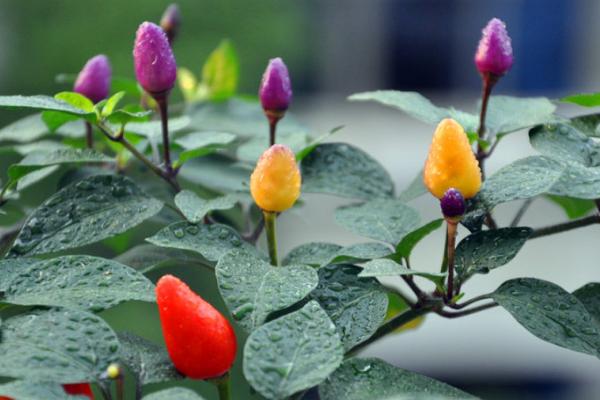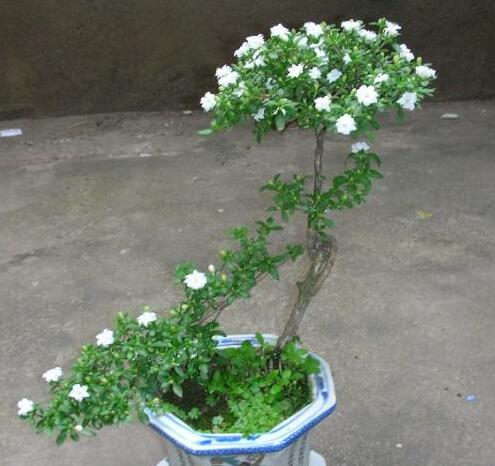Cultivation techniques of Lycium barbarum bonsai
In the cultivation technology of Chinese wolfberry bonsai, the main root of Chinese wolfberry is shallow, and the root system grows near the surface, and the root system should be truncated when transplanting in spring. The basin soil can be used with humus soil or pastoral soil mixed with appropriate amount of sandy soil or old wall soil. Apply human organic fertilizer to the bottom of the basin as base fertilizer. After planting, put it in the shade and pour water through it. It can be moved to the sun for about 10 days. Lycium barbarum is a temperate tree species, which not only likes sunshine, but also can tolerate shade. It should be planted in the sun. When potted, it is necessary to ensure that there is enough direct sunlight during the growing period, winter can be overwintered in the open field, and the low temperature of minus 3 ℃ will not freeze to death, but it is best to move indoors and keep the temperature above o ℃.
Lycium barbarum roots shallow, watering should be diligent, in order to keep the basin soil moist, but should not be wet. Proper water control during flowering and adequate watering during fruit setting. Chinese wolfberry likes to be fat and is very tolerant to barren. Fertilizer should be applied frequently and thinly. In early summer (before flowering) and early autumn (fruit growing period), thick cake fertilizer and water should be applied once or twice, and phosphorus and potassium fertilizer should be added. Base fertilizer should be applied after fruit picking.
The branches of Chinese wolfberry are slender, arched, curved and open, and the fruit bears in the axils of short branches. Pot modeling can refer to grape shaping, there are funnel shape, fan shape and so on. The pruning measures of Chinese wolfberry include leaf picking, cutting and so on, in order to ensure good ventilation and light transmittance and the most branches. The purpose of picking leaves is to improve the freshness and fruit of the plant.
Picking leaves once at the beginning of summer, picking 6-7 leaves each time (6-10-7-10-10 are mainly old leaves) can promote the growth of new leaves and buds. Before and after picking leaves, fertilize slightly thicker and add phosphorus and potash fertilizer. In early autumn (September), the overgrown branches and dense branches can be cut off, the leaf branches are removed 8 times, 10 times, 9 times, 10 times, and then apply heavy fertilizer once more. After four or five days, the tender leaves and buds will grow at the same time, and by the middle of October, the fruit color will change from yellow to red, and the red fruits will hang all over the branches and move indoors, but there will be a longer viewing time. The above is the introduction to the cultivation techniques of Chinese wolfberry bonsai.
Rapid cultivation of Chinese wolfberry bonsai
There are wild Chinese wolfberry all over the country, and it is easy to get materials. In autumn, all the leaf axils of Chinese wolfberry are full of lavender flowers. Some leaf axils can even open five or six, after the flowers are full of fruit, bright red transparent, until the end of autumn and early winter is still bright red, the use of Chinese wolfberry bonsai can be regarded as a wonderful product. Chinese wolfberry has a long life, and it is not surprising that Chinese wolfberry for decades or even hundreds of years. 1. Hardwood cuttings: at the end of February and early March, the dried wild Lycium barbarum was intercepted and trimmed according to the needs of imprisonment, and the bottom was trimmed with a sharp knife, then soaked in a 500 times Huolibao solution, directly inserted into an ornamental basin full of plain soil, watered and buried in the ground, and the exposed parts should be cultivated to raise the mound, spray water and cover with plastic sheeting to protect moisture, with a survival rate of 100%. At the end of February 1992, Huayou planed a century-old pile of Chinese wolfberry from other places, the trunk was hollow, and most of the lateral branches were hollow. According to the modeling needs, six sections were intercepted, and all the cuttings survived according to the above method. 24 plants were cut according to this method in 1993 and 1994, all of which were successful. 2. Management after insertion: always check whether the plastic sheeting has water droplets. If there are no water droplets, you should spray water on the mound to keep it moist. When Chinese wolfberry sprouts, open both ends of the plastic sheet to ventilate. When the buds grow to about 10cm, remove the plastic sheeting, receive light, gradually remove the mound, and spray 500 times Hulibao liquid fertilizer every 15 days. By the end of June, before entering the high temperature, the Chinese wolfberry was pulled out of the ground for normal management. Watering should be dry and wet, and apply liquid fertilizer containing more phosphorus every ten days or so. When it came to the day of flowering, there were only hanging green vines, covered in four directions, and the branches full of lavender flowers were laid with the wind, charming and moving. The autumn fruit is ripe, as if thousands of red stones are covered with hanging branches, and a pot of wonderful bonsai is reflected in front of us.
Cultivation techniques of Flower Bonsai
China is known as the "mother of the world garden", rich in flower resources, a wide variety of flowers, in order to facilitate cultivation, management and utilization, it is necessary to understand the classification knowledge of flowers. Because the basis of classification is different. Therefore, the methods of classification are also different. Flowers are usually classified according to their growth habits and morphological characteristics, which can be divided into herbaceous flowers, woody flowers, succulent flowers and aquatic flowers.

Soilless cultivation techniques of bonsai
The soilless cultivation technology of flower bonsai is to put perlite, vermiculite or other light stones in the flowerpot (do not use plant decay, organic humus such as sawdust and cottonseed shell as cultivation substrate), and then add inorganic salt nutrient solution to cultivate flowers. The nutrient solution contains a variety of disinfection drugs, and the matrix in the basin is inorganic ore, so it does not breed insects, ants and bacteria; it also contains various elements needed for plant growth, which can make plants grow fast, plant strong, blossom more and early, big and fragrant, and resistant to cold and heat. Fewer diseases and insect pests. Today, only soilless cultivation of flower bonsai can be exported to advanced countries; soilless cultivation of indoor plants is more suitable for high-end hotels, restaurants, shopping malls, office buildings and modern living rooms. The bonsai cultivated in soilless culture has a good prospect in the market. In addition, fresh cut flowers and vegetables are cultivated in nutrient solution greenhouse, which can improve the yield and quality and supply the market all the year round.
Bonsai cultivation of flowers can be carried out at any time from soilless cultivation to soilless cultivation. The specific operation methods are as follows: prepare the nutrient solution to dilute the commercial soilless culture nutrient solution with tap water according to the prescribed multiple. Take off the basin and push the root out of the soil with your fingers from the hole at the bottom of the basin. Root washing soaks the root system with soil in water close to the ambient temperature and carefully washes the soil in the rhizosphere. Try not to hurt the root during the operation. Soak the washed root in a mixed nutrient solution for 10 minutes to fully absorb nutrients. Choose suitable size plastic basin, ceramic basin or porcelain basin (with tray) to clean. Place tiles or fill plastic yarn in the basin bottom hole, and then put a little perlite and vermiculite in the basin. Then put the root of the plant in a human basin and straighten it; then load light ores such as perlite and vermiculite around the root system and gently shake the flowerpot to make perlite and other roots close to the root system.
Immediately irrigate the nutrient solution from all around until there is a liquid flow out of the bottom hole of the basin. Although the substrates such as perlite and vermiculite are loose and breathable, it is not easy to fix the plant root. If necessary, quartz stone, axe stone and other fragments can be placed on the matrix of the root system to strengthen the root system and avoid lodging. The stump bonsai can also be rooted with quartz stone, which depends on the old trees and adds to the natural scenery. Arrange and spray water on the leaves of pots and spray some water on the leaves and clean up the appearance. Daily management of soilless cultivation of flower bonsai, the requirements of light, temperature, humidity and other environmental conditions are no different from those of soilless cultivation. In peacetime management should pay attention to timely watering tap water. During the growth of the plant, the nutrient solution was irrigated once a week, and the amount of nutrient solution was determined according to the plant size. The amount of flowers with slow-growing leaves should be reduced, and the winter or plant dormancy period should be watered once a month or half a month. Indoor foliage plants can survive under low light conditions, so the amount of nutrient solution should be reduced. Nutrient solution can also be used for foliar spraying. Bonsai soilless cultivation of flowers can generally use soilless culture solutions such as "plum blossom", "golden moon" and "Black Tortoise", or the best-selling "red plum" soilless culture solution in Shanghai and other places.
In the process of flower bonsai cultivation and management, timely and appropriate removal of leaves will help to improve the ornamental value of flower bonsai, prolong the viewing time, and promote branching and flowering and fruiting. Different kinds of flowers and trees, leaf picking period, leaf picking quantity, leaf picking purpose, and the maintenance and application before and after picking leaves are different. therefore, the leaf picking technology should be used correctly.
After the jasmine overwintered indoors, the jasmine was maintained in the sunny place for about 15 days, combined with turning the basin and changing the soil, removing all the old leaves, pruning the branches, cutting off the thin technical strips in the dense parts, and shortening all the branches. it has a good effect on promoting the growth and development of branches and leaves and the whole plant.
Milan has strong growth, abundant branches and leaves, can continue to branch leaves and blossom, but also continue to form dark green and dull old leaves, timely removal of these old leaves can make the whole plant leaf color bright green, avoid leaf color mixed, conducive to ventilation and light, reduce the breeding of diseases and insects, can reduce nutrient consumption, conducive to the growth and development of new branches, leaves and flower buds.
Chinese wolfberry has a strong nature, tender leaves and red fruits have good ornamental value, and they are good materials for bonsai. The potted structure does not allow blossom and fruit before autumn, and fertilizes quickly before and after the beginning of the autumn festival. A week later, 80-90% of the leaves are removed, while the branches are trimmed according to the shape. 10 days later, the new leaves come out together with the buds. After the new leaves are unfolded, cake, fertilizer and water are applied once a week to make the flowers flourish and the red fruits are full of branches after autumn.
Elm, Magnolia, pomegranate, crape myrtle, bauhinia, lobular privet and other tree species in the bonsai stump take leaf-making measures around early September or before they need to be exhibited. About 10 days before picking leaves, apply quick fertilizer once, in order to accumulate nutrients for new leaf germination, cut leaves with scissors, retain petioles, and sprout new leaves 20 days later, not only the new leaves are beautiful in color and vibrant, but also make the leaves smaller. It can better reflect the styling beauty of the branches.
The red maple leaves are bright red and eye-catching, but the old leaves talk secretly or return to green. They can be picked twice in June and September to keep the leaves bright red throughout the year and improve the ornamental effect.
In the application of leaf picking technology, untested tree species shall not be abused. Special care should be taken after making leaves. After a large number of leaves are picked, water metabolism is slow, soil moisture should be controlled, it is appropriate to avoid rain in case of heavy rain or continuous rain, fertilizer application should be suspended, and normal maintenance should be resumed after the new leaves are unfolded. Bonsai with weak trees should not pick leaves, otherwise, it will accelerate weakness or death.
Through the detailed introduction of this article, I hope you can gain something! Thank you for your support and attention to the succulent flower bed!
- Prev

Planting techniques of colorful Pepper
The planting technology of colorful pepper, colorful pepper, also known as colorful pepper, colorful pepper, Chaotian pepper and so on, Solanaceae perennial semi-woody plant, often used as annual cultivation. Leaves such as pepper, rafters slightly smaller, white flowers, a variety of fruit, for the variety of pepper. There are many varieties or horticultural varieties of the same kind: bright red in color
- Next

Breeding method of June snow
The propagation of snow in June is mainly by cutting, and it can also be divided and striped. The main results are as follows: 1. Cutting propagation is mostly carried out in the rainy season. Choose branches that are strong and disease-free, cut them into cuttings 8 to 10 centimeters long, and insert them directly into plain sand. Pour water after insertion and shade properly
Related
- Fuxing push coffee new agricultural production and marketing class: lack of small-scale processing plants
- Jujube rice field leisure farm deep ploughing Yilan for five years to create a space for organic food and play
- Nongyu Farm-A trial of organic papaya for brave women with advanced technology
- Four points for attention in the prevention and control of diseases and insect pests of edible fungi
- How to add nutrient solution to Edible Fungi
- Is there any good way to control edible fungus mites?
- Open Inoculation Technology of Edible Fungi
- Is there any clever way to use fertilizer for edible fungus in winter?
- What agents are used to kill the pathogens of edible fungi in the mushroom shed?
- Rapid drying of Edible Fungi

